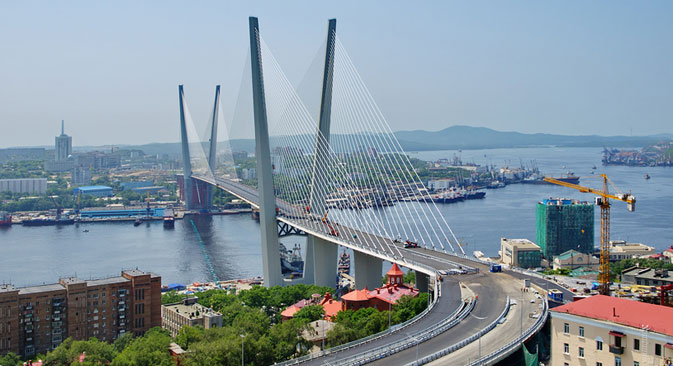
The Zolotoy Bridge allows pedestrians from 7 am till 9 pm. Source: Lori/Legion Media
Just a few years ago, a visit to Vladivostok gave foreigners a chance to see some of the rather unpleasant legacies of the Soviet Union. As soon as a domestic flight landed in the city, a police officer would come inside the aircraft and check the passports of all passengers before letting them get off. The police would also carefully scrutinize the documents of all passengers flying out of the city to make sure they registered with the authorities if they stayed more than three days. Long-term residents of the city used to mock such procedures by saying that the police were just following rules to the letter.
On a flight from Hong Kong to the Russian Far Eastern city this week, I asked the crew for the migration card that all foreign visitors have to fill when entering Russia. When an airhostess of the Russian airline said she had no idea what I was talking about, I braced myself for a long session at the airport, filling the card and then waiting in a long queue for passport control and dealing with a visibly irritated immigration officer, since my flight landed at 12:40 am.
Instead, I was surprised to see that the airport had the automated printing system in place for migration cards. I was later told that this was done in time for the 2012 APEC summit. Passport control took less than 3 minutes and there was even a warm smile on the face of the immigration officer. I spotted my suitcase almost immediately after clearing immigration. This was in contrast to my last trip when I waited half an hour for my suitcase (on a domestic fight that had about 25 passengers). The customs officials were also polite and (dare I say) friendly!
I did not need to use the train to the city center since a friend offered to pick me up from the airport, but I watched an official guide a couple from Hong Kong to the platform, and he spoke very good English. (I discovered later that the city center had street signs in English.)
In the not-so distant past, another problem with the airport, which is located in the small town of Artem, an hour’s drive away from Vladivostok, was the taxi mafia. There would be no buses after 6 pm from the airport and the taxi drivers waiting outside the airport would ask for ridiculous prices. Now, there are dedicated prepaid taxi offices inside the terminal. The airport experience in the city has been totally transformed and is hassle-free.
Visiting the city after a gap of 8 long years, I was happy to see the transformation that it has undergone. All the heritage and pre-Civil War buildings in the city center have been tastefully restored. The famous rotunda with a view of the Amur Gulf has also been restored, but unfortunately, vandals have sprayed it with graffiti yet again! The parks and the lawns across the city center are maintained well, and Vladivostok now feels more like an elegant European city than a rundown Soviet outpost.
Like many parts of central Russia, the Far Eastern city also feels much safer than it did during the last decade. Official crime statistics indicate a fall in violent crime and there is also much less visible public drunken behavior on the streets. A local friend joked that the city became calmer after the main Far Eastern University campus was moved to nearby Russky Island.
The two new cable-stayed bridges built in the city ahead of the 2012 APEC summit have also helped change the face of Vladivostok. The Zolotoy (Golden)
Bridge is open to pedestrians from 7 am till 9 pm. The views of Vladivostok’s Golden Horn at sunset from the bridge are (in my opinion) as beautiful as those from the Galata Bridge in Istanbul.
City authorities say plans are on for more international flights to Asian cities. They hope to cash in on a tourist boom that is expected when the city becomes a free port and allows visa-on-arrival to foreigners for 8-day visits. Several new tour agencies plan to offer excursions into the forests of the Primorye territory, as the free port zone extends well beyond the geographical boundaries of the city.
It remains to be seen how the city can compete for business with the likes of Busan, but the change in official attitudes has transformed Vladivostok, which is now one of the most tourist-friendly cities in northern Asia.
All rights reserved by Rossiyskaya Gazeta.
Subscribe
to our newsletter!
Get the week's best stories straight to your inbox